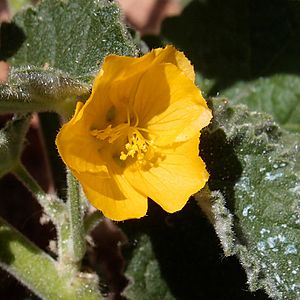Parish's Indian mallow facts for kids
Quick facts for kids Parish's Indian mallow |
|
|---|---|
 |
|
| Conservation status | |
| Scientific classification | |
| Genus: |
Abutilon
|
| Species: |
parishii
|
Abutilon parishii is a beautiful flowering plant. It belongs to the mallow family. People often call it Parish's Indian mallow or Pima Indian mallow. This plant naturally grows in Arizona, United States, and Sonora, Mexico.
Contents
What is Parish's Indian Mallow?
Parish's Indian mallow is a type of perennial herb. This means it lives for more than two years. It grows like a small bush. Most plants are about one meter (3 feet) tall. Some can even reach up to 1.9 meters (over 6 feet)!
Plant Features
The plant has one or many stems. These stems are covered in tiny, sticky hairs. The stems usually don't have many leaves. The leaves are shaped like an oval or a heart. They have jagged edges, like tiny teeth. Each leaf can be up to 10 centimeters (4 inches) long. They feel soft and velvety. The top side is dark green, and the bottom is very pale, almost white.
Flowers and Fruit
The flowers grow where the leaves meet the stem. They have pretty, pale orange petals. Each petal is about one centimeter (less than half an inch) long. These flowers are special! They only open when it's sunny. Usually, they open between 3:30 and 4:30 in the afternoon.
After the flowers, the plant makes a fruit. This fruit is called a schizocarp. It has 6 to 8 small parts inside. These parts are called mericarps. The fruits open up in June. They also open again after summer rains. This releases the seeds.
Seed Life Cycle
Getting the seeds to grow can be tricky. They don't germinate (sprout) very easily. Interestingly, older seeds are more likely to sprout than fresh ones. This is a unique feature of the plant's life cycle.
Where Does it Grow?
In Arizona, you can find Parish's Indian mallow in several mountain ranges. These include the Superstition, Tortolita, Santa Catalina, Tucson, Rincon, and Santa Rita Mountains.
Habitat and Neighbors
This plant loves rocky places. It often grows on the sides of canyons. Other plants that grow nearby include jojoba, saguaro cacti, triangle bur ragweed, hoary abutilon, ocotillo, and Palmer's abutilon.
Plant Populations
In 2001, scientists knew about 84 groups of this plant. They were found in Arizona and Sonora. These groups were spread across 17 different mountain ranges. Most of these groups are small. They only have a few plants.
Conservation Efforts
To help protect this plant, some are grown in special gardens. For example, you can see Parish's Indian mallow at the Desert Botanical Garden in Phoenix, Arizona. This helps scientists study the plant and keep it safe.


